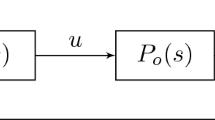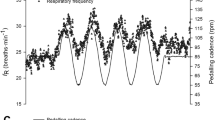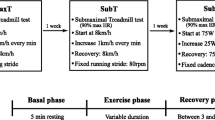Abstract
Long-range dependency has been found in most rhythmic motor signals. The origin of this property is unknown and largely debated. There is a controversy on the influence of voluntary control induced by requiring a pre-determined pace such as asking subjects to step to a metronome. We studied the cycle duration variability of 15 men pedaling on an ergometer at free pace and at an imposed pace (60 rpm). Revolution time was determined based on accelerometer signals (sample frequency 512 Hz). Revolution time variability was assessed by coefficient of variation (CV). The presence of long-range autocorrelations was based on scaling properties of the series variability (Hurst exponent) and the shape of the power spectral density (α exponent). Mean revolution time was significantly lower at freely chosen cadence, while values of CV were similar between both sessions. Long-range autocorrelations were highlighted in all series of cycling patterns. However, Hurst and α exponents were significantly lower at imposed cadence. This study demonstrates the presence of long-range autocorrelations during cycling and that voluntary intent can modulate the interdependency between consecutive cycles. Therefore, cycling may constitute a powerful paradigm to investigate the influence of central control mechanisms on the long-range interdependency characterizing rhythmic motor tasks.




Similar content being viewed by others
References
Bassingthwaighte, J. B., and G. M. Raymond. Evaluating rescaled ranged analysis for time series. Ann. Biomed. Eng. 22:432–444, 1994.
Bollens, B., F. Crevecoeur, C. Detrembleur, E. Guillery, and T. Lejeune. Effects of age and walking speed on long-range autocorrelations and fluctuation magnitude of stride duration. Neuroscience 210:234–242, 2012.
Bollens, B., F. Crevecoeur, V. Nguyen, C. Detrembleur, and T. Lejeune. Does human gait exhibit comparable and reproducible long-range autocorrelations on level ground and on treadmill? Gait Posture 32:369–373, 2012.
Borg, G. A. Psychophysical bases of perceived exertion. Med. Sci. Sports Exerc. 14:377–381, 1982.
Borg, E., and L. Kaijser. A comparison between three rating scales for perceived exertion and two different work tests. Scand. J. Med. Sci. Sports 16(1):57–69, 2006.
Crevecoeur, F., B. Bollens, C. Detrembleur, and T. M. Lejeune. Towards a “gold-standard” approach to address the presence of long-range auto-correlation in physiological time series. J. Neurosci. Methods 192:163–172, 2010.
Delignières, D., and K. Torre. Fractal dynamics of human gait: a reassessment of the 1996 data of Hausdorff et al. J. Appl. Physiol. 106:1272–1279, 2009.
Dingwell, J. B., J. John, and J. P. Cusumano. Do humans optimally exploit redundancy to control step variability in walking? PLoS Comput. Biol. 6:e1000856, 2010.
Diniz, A., M. L. Wijnants, K. Torre, J. Barreiros, N. Crato, A. M. Bosman, F. Hasselman, R. F. Cox, G. C. Van Orden, and D. Delignières. Contemporary theories of 1/f noise in motor control. Hum. Mov. Sci. 30:889–905, 2011.
Garcia, M., A. Chatterjee, A. Ruina, and M. Coleman. The simplest walking model: stability, complexity, and scaling. J. Biomech. Eng. 120:281–288, 1998.
Gates, D. H., and J. B. Dingwell. Peripheral neuropathy does not alter the fractal dynamics of stride intervals of gait. J. Appl. Physiol. 102:965–971, 2007.
Gates, D. H., J. L. Su, and J. B. Dingwell. Possible biomechanical origins of the long-range correlations in stride intervals of walking. Phys. A 380:259–270, 2007.
Goldberger, A. L., L. A. Amaral, J. M. Hausdorff, P. Ch. Ivanov, C. K. Peng, and H. E. Stanley. Fractal dynamics in physiology: alterations with disease and aging. Proc Natl Acad Sci U S A. 99:2466–2472, 2002.
Hausdorff, J. M. Gait dynamics, fractals and falls: finding meaning in the stride-to-stride fluctuations of human walking. Hum. Mov. Sci. 26:555–589, 2007.
Hausdorff, J. M., Y. Ashkenazy, C. K. Peng, P. C. Ivanov, H. E. Stanley, and A. L. Golberger. When human walking becomes random walking: fractal analysis and modeling of gait rhythm fluctuations. Phys. A 302:138–147, 2001.
Hausdorff, J. M., S. L. Mitchell, R. Firtion, C. K. Peng, M. E. Cudkowicz, J. Y. Wei, and A. L. Goldberger. Altered fractal dynamics of gait: reduced stride-interval correlations with aging and Huntington’s disease. J. Appl. Physiol. 82:262–269, 1997.
Hausdorff, J. M., C. K. Peng, Z. Ladin, J. Y. Wei, and A. L. Goldberger. Is walking a random walk? Evidence for long-range correlations in stride interval of human gait. J. Appl. Physiol. 78:349–358, 1995.
Hausdorff, J. M., P. Purdon, C. K. Peng, Z. Ladin, J. Y. Wei, and A. L. Goldberger. Fractal dynamics of human gait: stability of long-range correlations in stride interval fluctuations. J. Appl. Physiol. 80:1448–1457, 1996.
Kurz, M. J., K. Markopoulou, and N. Stergiou. Attractor divergence as a metric for assessing walking balance. Nonlinear Dyn. Psychol. Life Sci. 14(2):151–164, 2010.
Kurz, M. J., and N. Stergiou. An artificial neural network that utilizes hip joint actuations to control bifurcations and chaos in a passive dynamic bipedal walking model. Biol. Cybern. 93(3):213–221, 2005.
Kurz, M. J., and N. Stergiou. Do horizontal propulsive forces influence the nonlinear structure of locomotion? J. Neuroeng. Rehabil. 4:30, 2007.
MacKay-Lyons, M. Central pattern generation of locomotion: a review of the evidence. Phys. Ther. 82:69–83, 2002.
Mc Fadyen, B. L., L. Bouyer, L. R. Bent, and J. T. Inglis. Visual-vestibular influences on locomotor adjustments for stepping over an obstacle. Exp. Brain Res. 179:235–243, 2007.
Padulo, J., R. Di Capua, and D. Viggiano. Pedaling time variability is increased in dropped riding position. Eur. J. Appl. Physiol. 112:3161–3165, 2012.
Peng, C. K., S. Havlin, H. E. Stanley, and A. L. Goldberger. Quantification of scaling exponents and crossover phenomena in nonstationary heartbeat time series. Chaos 5:82–87, 1995.
Raasch, C. C., and F. E. Zajac. Locomotor strategy for pedaling: muscle groups and biomechanical functions. J. Neurophysiol. 82:515–525, 1999.
Ranganathan, R., and K. M. Newell. Online feedback and the regulation of degrees of freedom in motor control. Hum. Mov. Sci. 27:577–589, 2008.
Rangarajan, G., and M. Ding. Integrated approach to the assessment of long range correlation in time series data. Phys. Rev. E 61:4991–5001, 2000.
Scafetta, N., D. Marchi, and B. J. West. Understanding the complexity of human gait dynamics. Chaos 19:026108, 2009.
Seely, A. J., and P. T. Macklem. Complex systems and the technology of variability analysis. Crit. Care 8:367–384, 2004.
Snijders, A. H., I. Toni, E. Ružička, and B. R. Bloem. Bicycling breaks the ice for freezers of gait. Mov. Disord. 26:367–371, 2011.
Stergiou, N., and L. M. Decker. Human movement variability, nonlinear dynamics, and pathology: is there a connection? Hum. Mov. Sci. 30:869–888, 2011.
Terrier, P., and O. Dériaz. Persistent and anti-persistent pattern in stride-to-stride variability of treadmill walking: influence of rhythmic auditory cueing. Hum. Mov. Sci. 31:1585–1597, 2012.
Theiler, J., S. Eubank, A. Longtin, B. Galdrikian, and D. Farmer. Testing for nonlinearity in time series: the method of surrogate data. Phys. D 58:77–94, 1992.
West, B. J., and N. Scafetta. Nonlinear dynamical model of human gait. Phys. Rev. E 67:051917, 2003.
Whitty, A. G., A. J. Murphy, A. J. Coutts, and M. L. Watsford. Factors associated with the selection of the freely chosen cadence in non-cyclists. Eur. J. Appl. Physiol. 106:705–712, 2009.
Acknowledgments
The authors would like to thank all of the subjects for participating in this study. Benjamin BOLLENS was supported by the Belgian National Fund for Scientific Research (FNRS).
Conflict of interest
None of the authors of this manuscript have a conflict of interest to declare.
Author information
Authors and Affiliations
Corresponding author
Additional information
Associate Editor Nicholas Stergiou oversaw the review of this article.
Rights and permissions
About this article
Cite this article
Warlop, T.B., Bollens, B., Crevecoeur, F. et al. Dynamics of Revolution Time Variability in Cycling Pattern: Voluntary Intent Can Alter the Long-Range Autocorrelations. Ann Biomed Eng 41, 1604–1612 (2013). https://doi.org/10.1007/s10439-013-0834-2
Received:
Accepted:
Published:
Issue Date:
DOI: https://doi.org/10.1007/s10439-013-0834-2




